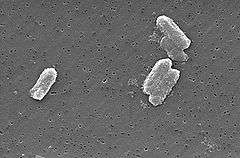Citrobacter freundii
| Citrobacter freundii | |
|---|---|
 | |
| Scientific classification | |
| Kingdom: | Bacteria |
| Phylum: | Proteobacteria |
| Class: | Gammaproteobacteria |
| Order: | Enterobacteriales |
| Family: | Enterobacteriaceae |
| Genus: | Citrobacter |
| Species: | C. freundii |
| Binomial name | |
| Citrobacter freundii (Braak 1928) Werkman and Gillen 1932[1] | |
Citrobacter freundii is a species of facultative anaerobic gram-negative bacteria of the Enterobacteriaceae family.[2] The bacteria are long bacterial rods with a typical length of 1–5 μm.[3] Most C. freundii cells generally have several flagella used for locomotion, but some do not and are non-motile. C. freundii is a soil organism, but can also be found in water, sewage, food and in the intestinal tracts of animals and humans.[3] The Citrobacter genus was discovered in 1932 by Werkman and Gillen. Cultures of C. freundii were isolated and identified in the same year from soil extracts.[3]
As an opportunistic pathogen, C. freundii is responsible for a number of significant infections. It is known to be the cause of nosocomial infections of the respiratory tract, urinary tract, blood, and many other normally sterile sites in patients.[4] C. freundii represents about 29% of all opportunistic infections.[4]
Though a pathogen to humans, this infectious microbe in humans plays an important role in the nitrogen cycle in the environment. C. freundii is responsible for reducing nitrate to nitrite in the environment.[5] This conversion is an important and crucial stage in the nitrogen cycle.
C. freundii has also been investigated for biodegradation of tannic acid used in tanneries.[5]
C. freundii has the ability to grow on glycerol, and use it as its sole source of carbon and energy. The organism contains a bacterial microcompartment which is capable of processing propanediol.[6]
References
- ↑ LPSN bacterio.net
- ↑ "Citrobacter SPP.". Pathogen Safety Data Sheet — Infectious Substances. Public Health Agency of Canada. 2012.
- 1 2 3 Wang, J. T.; Chang, S. C.; Chen, Y. C.; Luh, K. T. (2000). "Comparison of antimicrobial susceptibility of Citrobacter freundii isolates in two different time periods". Journal of microbiology, immunology, and infection = Wei mian yu gan ran za zhi. 33 (4): 258–262. PMID 11269372.
- 1 2 Whalen, J. G.; Mully, T. W.; English, J. C. (2007). "Spontaneous Citrobacter freundii Infection in an Immunocompetent Patient". Archives of Dermatology. 143 (1): 124–125. doi:10.1001/archderm.143.1.124. PMID 17224563.
- 1 2 Puchenkova, S. G. (1996). "Enterobacteria in areas of water along the Crimean coast". Mikrobiolohichnyi zhurnal (Kiev, Ukraine : 1993). 58 (2): 3–7. PMID 8983520.
- ↑ Pang, A.; Warren, M. J.; Pickersgill, R. W. (2011). "Structure of PduT, a trimeric bacterial microcompartment protein with a 4Fe–4S cluster-binding site". Acta Crystallographica Section D. 67 (2): 91–96. doi:10.1107/S0907444910050201. PMID 21245529.
External links
- "Citrobacter freundii". NCBI Taxonomy Browser. 546.
- Type strain of Citrobacter freundii at BacDive - the Bacterial Diversity Metadatabase